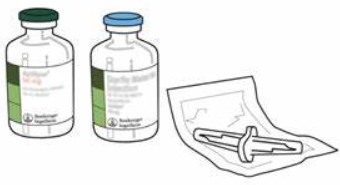ADMINISTERING TISSUE PLASMINOGEN ACTIVATOR (TPA) FOR ISCHEMIC STROKE
Stroke is a clinical syndrome, believed to be of vascular origin, presents with sudden signs of localized or widespread brain dysfunction lasting more than 24 hours and may result in disability or in death. This can manifest as ischemic cerebral infarction (about 87% of cases) or as intracerebral hemorrhage (about 13%).
One of the treatments for ISCHEMIC STROKE is thrombolytic therapy.
Candidates for thrombolytic therapy are given the appropriate therapy within the shortest time possible based on evidence-based guidelines such as the AHA.
The window of opportunity for eligible patients to receive thrombolytic therapy for acute ischemic stroke is THREE to FOUR AND A HALF hours from a clearly defined time last known well or the onset of signs/symptoms
The door-to-needle time (time of bolus administration) should be within 60 minutes from hospital arrival.
IV rTPA Administration:
0.9 mg/kg to a maximum of 90 mg
First 10% of calculated dose given as intravenous bolus dose
Remaining 90% of calculated dose given in infusion over 1 hour
o Verify that the Physician has reviewed the inclusion/exclusion criteria and discussed the plan with the patient and/or family if available.
o Verify that administration will start within three hours of symptom onset or time last known well (Verbal Consent of pt./family). If administering after 3 hours, a written consent is needed. Follow your hospital's policy.
Equipment Needed:
o 1 vial of Alteplase (Activase) 50mg or 100 mg
o One 10 ml syringe
o 50ml syringe and vented spike connector for the 50mg vial (does not come with kit)
o Two 19-gauge needles
o One blunt cannula
o Standard pump tubing
o Intravenous infusion pump
o 100 cc bag of 0.9% NS
o Alcohol wipes
o Two Medication labels
Administration Procedure:
o Verify the bolus dose and the infusion dose.
o Reconstitute the vial of t-PA with the supplied preservative-free water
o Direct stream of water into lypophilized cake
o Swirl but DO NOT SHAKE (slight foaming is common)
o Let stand several minutes to allow large bubbles to dissipate
o Final concentration is 1 mg/ml
o Fill out IV medication label with all required information (patient name, medication, dosage, time, date, RN signature) and affix label to Alteplase bottle.
o Draw waste dose from bottle and verify waste amount by showing to the Stroke
Neurologist/Physician and another nurse.
o Connect Activase bottle to IV pump tubing, carefully priming to avoid discarding any medication.
o Verify patency of IV site and tubing connections
o Verify that all blood work has been drawn and sent
o Attach noninvasive blood pressure cuff to other arm
o Set infusion pump rate for bolus dose to be given over 1 minute and infusion dose according to
dosing sheet with a total infusion time of 1 hour.
o For manual bolus administration (as requested by the Physician/Neurologist), using a 10 ml syringe, withdraw the bolus dose directly from the Activase bottle (see dosing sheet for bolus dose based on patient weight*).
o Fill out medication label with all required information (patient name, medication, dosage, time, date, RN signature). Hand the bolus dose syringe to the Stroke Neurologist/Physician.
o Ensure that the patient’s systolic is <180 and diastolic is <110 prior to and during infusion.
o Document infusion start time and name of Physician/Stroke Neurologist (as needed).
o When pump alarms "no flow above", there is still some medication left in the tubing which must be infused. Remove the IV tubing connector from the Activase bottle and attach it to a newly spiked 100 cc bag of 0.9% NS.
o Continue the infusion at the current setting to deliver the remainder of the original Activase volume over the remaining time. Continue the infusion until the preset volume is completed.
o Document end time of infusion.
Monitoring
Once infusion begins monitor vital signs and neurologic status as follows:
Every 15 min for 2 hours, then:
Every 30 minutes for 6 hours, then:
Every 60 minutes for 16 hours
*Notify physician immediately if SBP/DBP greater than 175/100
Precautions and Side Effects
√Hemorrhage (GI, GU, catheter puncture site, intracranial, retroperitoneal, pericardial,
gingival, epistaxis). NO blood works for 24 hours (except for emergent lab.).
√New ischemic stroke
√ Bruising
√Anaphylaxis
√Laryngeal edema
√Rash, urticaria
o If the patient’s neurologic status declines during tPA infusion the following actions should be taken:
Stop the infusion
Page the Stroke Neurologist
Draw and send PT/PTT, D-Dimer and fibrinogen
Prepare for emergent CT
NOTE: Always follow your hospital policy on TPA administration.
References: guidelines-for-mangaging-patients-with-ais-2019-update-to-2018-guidelines.pdf (stroke.org)
Acute Ischemic Stroke Resources | American Stroke Association





.png)
No comments:
Post a Comment